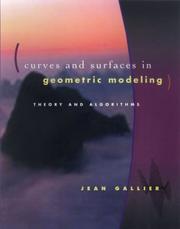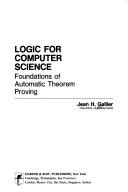| Listing 1 - 10 of 21 | << page >> |
Sort by
|
Book
ISBN: 1441980466 1441980474 Year: 2011 Publisher: New York, NY : Springer New York : Imprint: Springer,
Abstract | Keywords | Export | Availability | Bookmark
 Loading...
Loading...Choose an application
- Reference Manager
- EndNote
- RefWorks (Direct export to RefWorks)
This book gives an introduction to discrete mathematics for beginning undergraduates and starts with a chapter on the rules of mathematical reasoning. This book begins with a presentation of the rules of logic as used in mathematics where many examples of formal and informal proofs are given. With this logical framework firmly in place, the book describes the major axioms of set theory and introduces the natural numbers. The rest of the book deals with functions and relations, directed and undirected graphs and an introduction to combinatorics, partial orders and complete induction. There is a section on public key cryptography and RSA, with complete proofs of Fermat's little theorem and the correctness of the RSA scheme, as well as explicit algorithms to perform modular arithmetic. The last chapter provides more graph theory where Eulerian and Hamiltonian cycles are discussed. This book also includes network flows, matchings, covering, bipartite graphs, planar graphs and state the graph minor theorem of Seymour and Robertson. The book is highly illustrated and each chapter ends with a list of problems of varying difficulty. Undergraduates in mathematics and computer science will find this book useful. .
Computer science -- Mathematics. --- Electronic books. -- local. --- Mathematics --- Computer vision --- Number theory --- Engineering design --- Engineering & Applied Sciences --- Physical Sciences & Mathematics --- Algebra --- Computer Science --- Computer science --- Mathematics. --- Computer mathematics --- Discrete mathematics --- Electronic data processing --- Computer graphics. --- Applied mathematics. --- Engineering mathematics. --- Number theory. --- Engineering design. --- Number Theory. --- Computer Imaging, Vision, Pattern Recognition and Graphics. --- Engineering Design. --- Applications of Mathematics. --- Design, Engineering --- Engineering --- Industrial design --- Strains and stresses --- Number study --- Numbers, Theory of --- Engineering analysis --- Mathematical analysis --- Automatic drafting --- Graphic data processing --- Graphics, Computer --- Computer art --- Graphic arts --- Engineering graphics --- Image processing --- Math --- Science --- Design --- Digital techniques --- Computer vision. --- Machine vision --- Vision, Computer --- Artificial intelligence --- Pattern recognition systems --- Optical data processing. --- Optical computing --- Visual data processing --- Bionics --- Integrated optics --- Photonics --- Computers --- Optical equipment
Book
ISBN: 1441999604 1441999612 Year: 2011 Publisher: New York, NY : Springer New York : Imprint: Springer,
Abstract | Keywords | Export | Availability | Bookmark
 Loading...
Loading...Choose an application
- Reference Manager
- EndNote
- RefWorks (Direct export to RefWorks)
This book is an introduction to the fundamental concepts and tools needed for solving problems of a geometric nature using a computer. It attempts to fill the gap between standard geometry books, which are primarily theoretical, and applied books on computer graphics, computer vision, robotics, or machine learning. This book covers the following topics: affine geometry, projective geometry, Euclidean geometry, convex sets, SVD and principal component analysis, manifolds and Lie groups, quadratic optimization, basics of differential geometry, and a glimpse of computational geometry (Voronoi diagrams and Delaunay triangulations). Some practical applications of the concepts presented in this book include computer vision, more specifically contour grouping, motion interpolation, and robot kinematics. In this extensively updated second edition, more material on convex sets, Farkas’s lemma, quadratic optimization and the Schur complement have been added. The chapter on SVD has been greatly expanded and now includes a presentation of PCA. The book is well illustrated and has chapter summaries and a large number of exercises throughout. It will be of interest to a wide audience including computer scientists, mathematicians, and engineers. Reviews of first edition: "Gallier's book will be a useful source for anyone interested in applications of geometrical methods to solve problems that arise in various branches of engineering. It may help to develop the sophisticated concepts from the more advanced parts of geometry into useful tools for applications." (Mathematical Reviews, 2001) "...it will be useful as a reference book for postgraduates wishing to find the connection between their current problem and the underlying geometry." (The Australian Mathematical Society, 2001) .
Engineering mathematics. --- Geometry. --- Geometry --- Mathematics --- Physical Sciences & Mathematics --- Engineering --- Engineering analysis --- Mathematics. --- Computer graphics. --- Mathematical optimization. --- Control engineering. --- Robotics. --- Mechatronics. --- Computer Imaging, Vision, Pattern Recognition and Graphics. --- Control, Robotics, Mechatronics. --- Optimization. --- Euclid's Elements --- Mathematical analysis --- Computer vision. --- Optimization (Mathematics) --- Optimization techniques --- Optimization theory --- Systems optimization --- Maxima and minima --- Operations research --- Simulation methods --- System analysis --- Machine vision --- Vision, Computer --- Artificial intelligence --- Image processing --- Pattern recognition systems --- Optical data processing. --- Optical computing --- Visual data processing --- Bionics --- Electronic data processing --- Integrated optics --- Photonics --- Computers --- Mechanical engineering --- Microelectronics --- Microelectromechanical systems --- Automation --- Machine theory --- Control engineering --- Control equipment --- Control theory --- Engineering instruments --- Programmable controllers --- Optical equipment
Digital
ISBN: 9781441980472 Year: 2011 Publisher: New York, NY Springer New York
Abstract | Keywords | Export | Availability | Bookmark
 Loading...
Loading...Choose an application
- Reference Manager
- EndNote
- RefWorks (Direct export to RefWorks)
Digital
ISBN: 9781441999610 Year: 2011 Publisher: New York, NY Springer New York
Abstract | Keywords | Export | Availability | Bookmark
 Loading...
Loading...Choose an application
- Reference Manager
- EndNote
- RefWorks (Direct export to RefWorks)

ISBN: 0387950443 Year: 2001 Publisher: New York, N.Y. Springer
Abstract | Keywords | Export | Availability | Bookmark
 Loading...
Loading...Choose an application
- Reference Manager
- EndNote
- RefWorks (Direct export to RefWorks)

ISBN: 1558605991 Year: 2000 Publisher: San Francisco (Calif.) Morgan Kaufmann
Abstract | Keywords | Export | Availability | Bookmark
 Loading...
Loading...Choose an application
- Reference Manager
- EndNote
- RefWorks (Direct export to RefWorks)
Artificial intelligence. Robotics. Simulation. Graphics --- Curves, Algebraic --- Surfaces --- Computer-aided design --- Courbes algébriques --- Conception assistée par ordinateur --- Data processing --- Informatique --- -Surfaces --- -Curved surfaces --- Geometry --- Shapes --- Algebraic curves --- Algebraic varieties --- CAD (Computer-aided design) --- Computer-assisted design --- Computer-aided engineering --- Design --- Computer-aided design. --- Data processing. --- -Data processing --- Courbes algébriques --- Conception assistée par ordinateur --- Curved surfaces

ISBN: 0060422254 9780060422257 Year: 1986 Volume: 5 Publisher: New York : Harper & Row,
Abstract | Keywords | Export | Availability | Bookmark
 Loading...
Loading...Choose an application
- Reference Manager
- EndNote
- RefWorks (Direct export to RefWorks)
Automatic theorem proving --- Logic, symbolic and mathematical --- Logic, Symbolic and mathematical --- 681.3*F41 --- Algebra of logic --- Logic, Universal --- Mathematical logic --- Symbolic and mathematical logic --- Symbolic logic --- Mathematics --- Algebra, Abstract --- Metamathematics --- Set theory --- Syllogism --- Automated theorem proving --- Theorem proving, Automated --- Theorem proving, Automatic --- Artificial intelligence --- Proof theory --- Mathematical logic: computability theory; computational logic; lambda calculus; logic programming; mechanical theorem proving; model theory; proof theory;recursive function theory--See also {681.3*F11}; {681.3*I22}; {681.3*I23} --- Automatic theorem proving. --- Logic, Symbolic and mathematical. --- 681.3*F41 Mathematical logic: computability theory; computational logic; lambda calculus; logic programming; mechanical theorem proving; model theory; proof theory;recursive function theory--See also {681.3*F11}; {681.3*I22}; {681.3*I23} --- Propositional calculus --- Logique mathématique --- Théorèmes --- Calcul des propositions --- Théorie de la démonstration --- Démonstration automatique --- Logique mathématique. --- Calcul des propositions. --- Théorie de la démonstration. --- Démonstration automatique. --- Logic --- Logic programming
Book
ISBN: 3642437109 3642343635 3642343643 Year: 2013 Publisher: Berlin, Heidelberg : Springer Berlin Heidelberg : Imprint: Springer,
Abstract | Keywords | Export | Availability | Bookmark
 Loading...
Loading...Choose an application
- Reference Manager
- EndNote
- RefWorks (Direct export to RefWorks)
This welcome boon for students of algebraic topology cuts a much-needed central path between other texts whose treatment of the classification theorem for compact surfaces is either too formalized and complex for those without detailed background knowledge, or too informal to afford students a comprehensive insight into the subject. Its dedicated, student-centred approach details a near-complete proof of this theorem, widely admired for its efficacy and formal beauty. The authors present the technical tools needed to deploy the method effectively as well as demonstrating their use in a clearly structured, worked example. Ideal for students whose mastery of algebraic topology may be a work-in-progress, the text introduces key notions such as fundamental groups, homology groups, and the Euler-Poincaré characteristic. These prerequisites are the subject of detailed appendices that enable focused, discrete learning where it is required, without interrupting the carefully planned structure of the core exposition. Gently guiding readers through the principles, theory, and applications of the classification theorem, the authors aim to foster genuine confidence in its use and in so doing encourage readers to move on to a deeper exploration of the versatile and valuable techniques available in algebraic topology.
Algebra. --- Arithmetical algebraic geometry. --- Mathematics. --- Topological algebras --- Mathematics --- Physical Sciences & Mathematics --- Geometry --- Algebras, Topological --- Topology. --- Algebraic topology. --- Manifolds (Mathematics). --- Complex manifolds. --- Manifolds and Cell Complexes (incl. Diff.Topology). --- Algebraic Topology. --- Cell aggregation --- Aggregation, Cell --- Cell patterning --- Cell interaction --- Microbial aggregation --- Topology --- Analysis situs --- Position analysis --- Rubber-sheet geometry --- Polyhedra --- Set theory --- Algebras, Linear --- Geometría diferencial de curvas y superficies (4103213) --- Bibliografía recomendada --- Topological algebras. --- Analytic spaces --- Manifolds (Mathematics) --- Geometry, Differential
Book
ISBN: 9781441999610 9781441999603 Year: 2011 Publisher: New York : Springer,
Abstract | Keywords | Export | Availability | Bookmark
 Loading...
Loading...Choose an application
- Reference Manager
- EndNote
- RefWorks (Direct export to RefWorks)
This book is an introduction to the fundamental concepts and tools needed for solving problems of a geometric nature using a computer. It attempts to fill the gap between standard geometry books, which are primarily theoretical, and applied books on computer graphics, computer vision, robotics, or machine learning. This book covers the following topics: affine geometry, projective geometry, Euclidean geometry, convex sets, SVD and principal component analysis, manifolds and Lie groups, quadratic optimization, basics of differential geometry, and a glimpse of computational geometry (Voronoi diagrams and Delaunay triangulations). Some practical applications of the concepts presented in this book include computer vision, more specifically contour grouping, motion interpolation, and robot kinematics. In this extensively updated second edition, more material on convex sets, Farkas's lemma, quadratic optimization and the Schur complement have been added. The chapter on SVD has been greatly expanded and now includes a presentation of PCA. The book is well illustrated and has chapter summaries and a large number of exercises throughout. It will be of interest to a wide audience including computer scientists, mathematicians, and engineers. Reviews of first edition: "Gallier's book will be a useful source for anyone interested in applications of geometrical methods to solve problems that arise in various branches of engineering. It may help to develop the sophisticated concepts from the more advanced parts of geometry into useful tools for applications." (Mathematical Reviews, 2001) "...it will be useful as a reference book for postgraduates wishing to find the connection between their current problem and the underlying geometry." (The Australian Mathematical Society, 2001)
Geometry --- Engineering sciences. Technology --- Artificial intelligence. Robotics. Simulation. Graphics --- Computer. Automation --- mechatronica --- industriële robots --- automatisering --- grafische vormgeving --- KI (kunstmatige intelligentie) --- geometrie --- EPUB-LIV-FT LIVMATHE LIVSTATI SPRINGER-B
Book
ISBN: 3030460401 3030460398 Year: 2020 Publisher: Cham : Springer International Publishing : Imprint: Springer,
Abstract | Keywords | Export | Availability | Bookmark
 Loading...
Loading...Choose an application
- Reference Manager
- EndNote
- RefWorks (Direct export to RefWorks)
This textbook offers an introduction to differential geometry designed for readers interested in modern geometry processing. Working from basic undergraduate prerequisites, the authors develop manifold theory and Lie groups from scratch; fundamental topics in Riemannian geometry follow, culminating in the theory that underpins manifold optimization techniques. Students and professionals working in computer vision, robotics, and machine learning will appreciate this pathway into the mathematical concepts behind many modern applications. Starting with the matrix exponential, the text begins with an introduction to Lie groups and group actions. Manifolds, tangent spaces, and cotangent spaces follow; a chapter on the construction of manifolds from gluing data is particularly relevant to the reconstruction of surfaces from 3D meshes. Vector fields and basic point-set topology bridge into the second part of the book, which focuses on Riemannian geometry. Chapters on Riemannian manifolds encompass Riemannian metrics, geodesics, and curvature. Topics that follow include submersions, curvature on Lie groups, and the Log-Euclidean framework. The final chapter highlights naturally reductive homogeneous manifolds and symmetric spaces, revealing the machinery needed to generalize important optimization techniques to Riemannian manifolds. Exercises are included throughout, along with optional sections that delve into more theoretical topics. Differential Geometry and Lie Groups: A Computational Perspective offers a uniquely accessible perspective on differential geometry for those interested in the theory behind modern computing applications. Equally suited to classroom use or independent study, the text will appeal to students and professionals alike; only a background in calculus and linear algebra is assumed. Readers looking to continue on to more advanced topics will appreciate the authors’ companion volume Differential Geometry and Lie Groups: A Second Course.
Differential geometry. --- Topological groups. --- Lie groups. --- Computer mathematics. --- Differential Geometry. --- Topological Groups, Lie Groups. --- Computational Mathematics and Numerical Analysis. --- Computer mathematics --- Electronic data processing --- Mathematics --- Groups, Lie --- Lie algebras --- Symmetric spaces --- Topological groups --- Groups, Topological --- Continuous groups --- Differential geometry
| Listing 1 - 10 of 21 | << page >> |
Sort by
|

 Search
Search Feedback
Feedback About
About Help
Help News
News